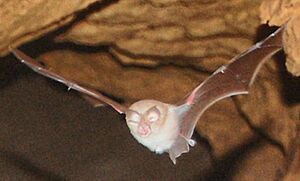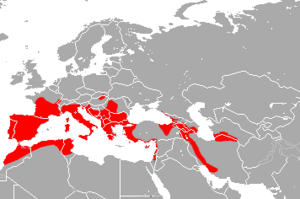Mediterranean horseshoe bat facts for kids
Quick facts for kids Mediterranean horseshoe bat |
|
|---|---|
 |
|
| Conservation status | |
| Scientific classification | |
| Genus: |
Rhinolophus
|
| Species: |
euryale
|
 |
|
| Mediterranean horseshoe bat range | |
The Mediterranean horseshoe bat (its scientific name is Rhinolophus euryale) is a type of bat. It's special because it eats insects. You can find these bats in places around the Mediterranean Sea, like the Balkan peninsula and parts of Italy.
What They Look Like
These bats are quite small. Their head and body are usually about 4.3 to 5.8 centimeters long. Their tail adds another 2.2 to 3 centimeters.
When their wings are spread out, they measure about 30 to 32 centimeters across. They weigh between 8 and 17.5 grams, which is like a few grapes!
Their fur feels soft and fluffy. It's light grey near their skin. The fur on their back is grey-brown, sometimes with a little reddish color. Their belly fur is grey-white or yellow-white.
Life and Habits
We don't know a lot about how Mediterranean horseshoe bats have babies. Mother bats gather in special nurseries. These nurseries can have anywhere from 50 to 400 females. Sometimes, male bats are there too.
Their main groups, called colonies, can be very large. They live in caves during summer and winter. These big colonies can have over 5,000 bats! Smaller groups, called satellite colonies, live nearby. They have dozens to hundreds of bats.
In summer, these bats often share their caves with other bat species. For example, in Bulgaria, they live with Blasius's horseshoe bats and Mehely's horseshoe bats. These bats are very sensitive to being disturbed.
Baby bats are usually born in mid-June or July. They become independent when they are about four weeks old. Female bats usually have their first baby when they are 2 or 3 years old. Mating happens in autumn inside caves. It can also continue in their winter homes.
Protecting These Bats
Since 2016, the Mediterranean horseshoe bat has been listed as Near Threatened. This means they could become endangered soon. Reports show their numbers have been going down for the last 27 years.
One reason for their decline is that more land is used for farming and cities. This means the bats lose the plants and areas they need to find insects to eat.
These bats mostly sleep and raise their young in caves and underground places. This makes them easily disturbed by people exploring caves or by cave tourism. Protecting their cave homes is a very important way to help them survive for a long time.


